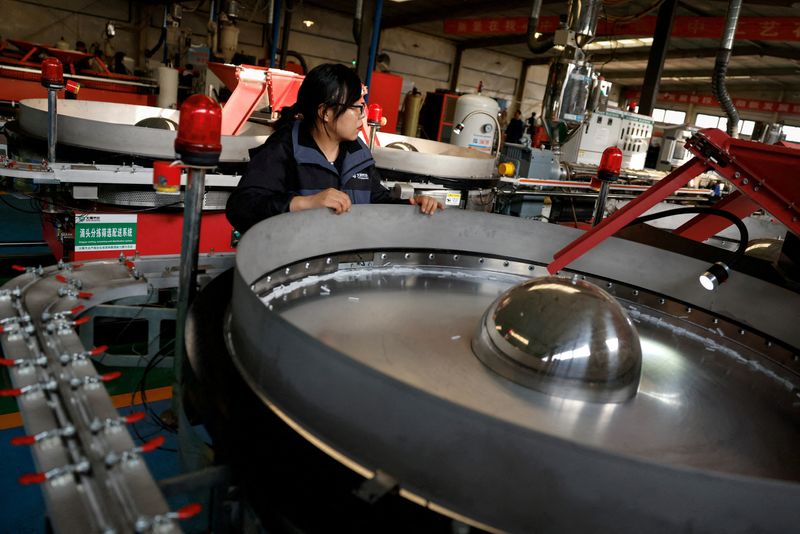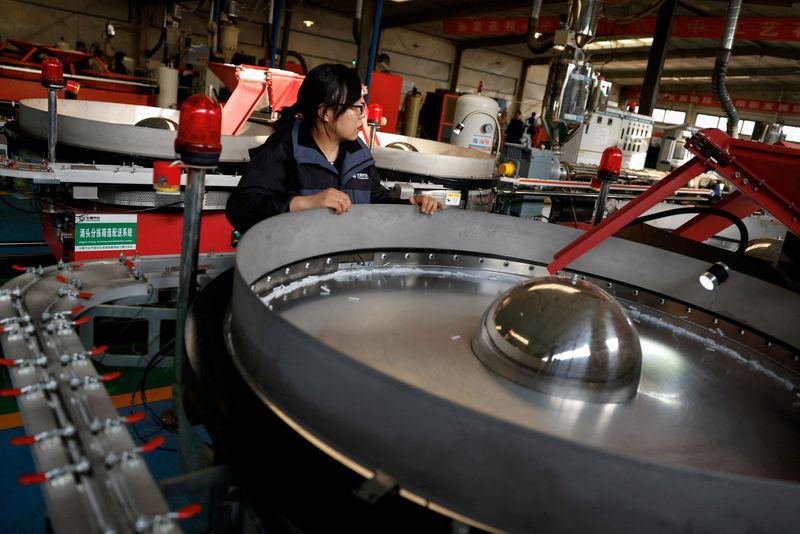
By Ellen Zhang and Kevin Yao
BEIJING (Reuters) – In one of their most dovish statements in more than a decade, Chinese leaders signalled on Monday they are ready to deploy whatever stimulus is needed to counter the impact of expected U.S. trade tariffs on next year’s economic growth.
After a meeting of top Communist Party officials, the Politburo, officials said they would switch to an “appropriately loose” monetary policy stance, and “more proactive” fiscal levers.
The previous “prudent” stance that the central bank had held for the past 14 years coincided with overall debt – including that of governments, households and companies – jumping more than 5 times. Gross domestic product (GDP) expanded roughly three times over the same period.
The Politburo rarely details policy plans, but the shift in its message shows China is willing to go even deeper into debt, prioritising, at least in the near term, growth over financial risks.
“From prudent to moderately loose is a big change,” said Shuang Ding, chief economist for Greater China and North Asia at Standard Chartered (OTC:SCBFF). “It leaves a lot of room for imagination.”
Tang Yao, associate professor of applied economics at Peking University, says this policy reset is needed, because slower growth would make debt even more difficult to service.
“They’ve by-and-large made peace with the fact that the debt-to-GDP ratio is going to rise further,” said Christopher Beddor, deputy China research director at Gavekal Dragonomics, adding that this was no longer “a binding constraint.”
It’s unclear how much monetary easing the central bank could deploy and how much more debt the finance ministry could issue next year. But analysts say that works in Beijing’s favour.
U.S. President-elect Donald Trump returns to the White House in January, having threatened tariffs in excess of 60% on U.S. imports of Chinese goods.
The timing and the ultimate level of the levies, which a Reuters poll last month predicted at nearly 40% initially, will determine Beijing’s response.
“They are willing to do ‘whatever it takes’ to achieve the GDP target,” said Larry Hu, chief China economist at Macquarie.
“But they will do so in a reactive way,” Hu said. “How much they will do in 2025 will depend on two things: their GDP target and the new U.S. tariffs.”
Next (LON:NXT) year’s 2025 growth, budget deficit and other targets will be discussed – but not announced – in coming days at an annual meeting of Communist Party leaders, known as the Central Economic Work Conference (CEWC).
Reuters reported last month that most government advisers recommend that Beijing should maintain a growth target of around 5%, even though that pace seemed difficult to reach throughout this year.
The tone of the Politburo statement suggests that China won’t lower its growth ambitions for 2025, says Zong Liang, chief researcher at state-owned Bank of China. But it also suggests that China is likely to set an initial budget deficit target of around 4%, its highest ever.
“Beijing may want to use the ‘around 5.0%’ growth target to show that it won’t cave to Trump’s threatened 60% tariff and other restrictive measures imposed on China,” said Ting Lu, chief China economist at Nomura, who also expects a 4% fiscal deficit, up from 3% in 2024.
A one percentage point increase in the deficit amounts to additional stimulus of about 1.3 trillion yuan ($179.4 billion), but China can add to that if needed by issuing off-budget special bonds or allowing local governments to do so.
Beijing is expected to gradually take on greater fiscal responsibility as local municipalities are too deep in debt.
‘NO.1 TASK’
China is facing strong deflationary pressures as consumers feel less wealthy due to a prolonged property crisis and minimal social welfare. Low household demand is a key risk to growth.
In an apparent nod to this risk, the Politburo pledged “unconventional counter-cyclical adjustments” and to “greatly boost consumption.”
The new wording suggests the composition of stimulus “will likely differ substantially from past cycles, with more focus on consumption, high-tech manufacturing, and risk containment rather than traditional infrastructure and property investment,” Goldman Sachs analysts said in a note.
Morgan Stanley (NYSE:MS) also read the statement as suggesting that elevating consumption will be “the No.1 key task for 2025,” but warned that “implementation remains uncertain.”
China has issued increasingly forceful statements on boosting consumption throughout the year, but it has offered little in terms of policies apart from a subsidy scheme for purchases of cars, appliances and a few other goods.
What else Beijing is prepared to do to boost consumption is another unknown. But demand-focused measures are key to improve the effectiveness of monetary policy easing in an economy that for decades has put production at its core.
“Monetary easing in China is far less potent than it used to be,” said Julian Evans-Pritchard, an analyst at Capital Economics.
“There is now limited appetite among households and large parts of the private sector to take on more debt, even at lower rates.”
($1 = 7.2453 Chinese yuan renminbi)
(Graphics by Kripa Jayaram; writing by Marius Zaharia; Editing by Kim Coghill)

